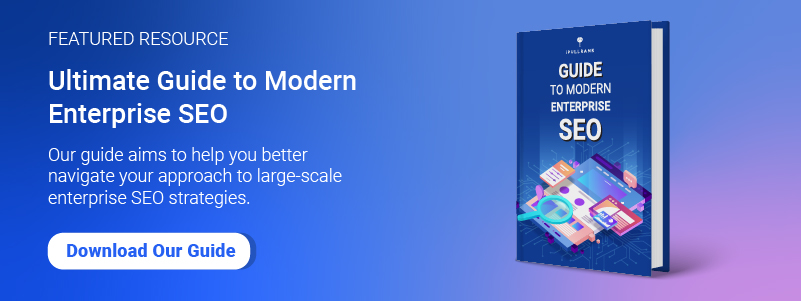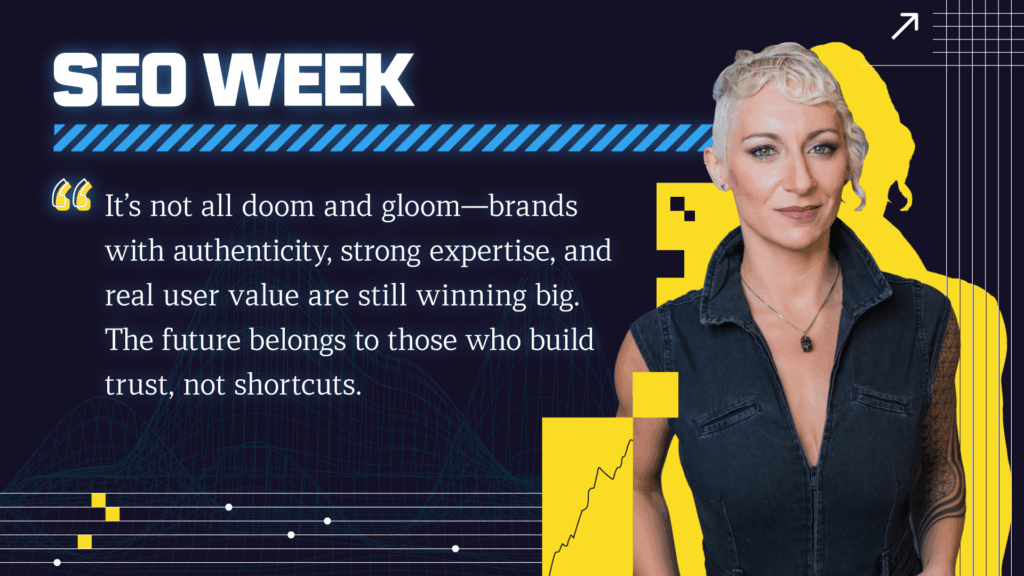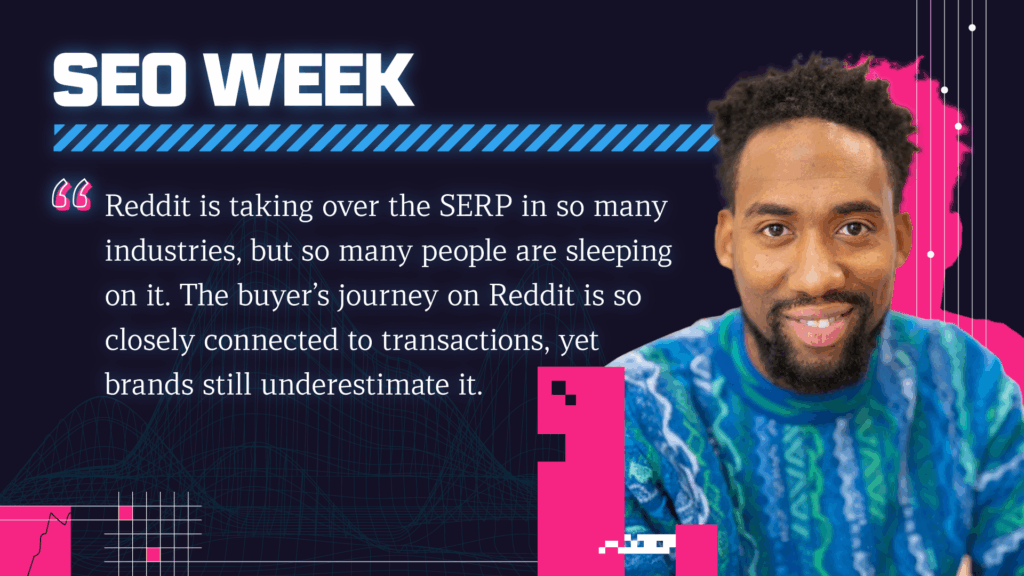Is your organization winning the enterprise SEO battle?
According to DigitalMarketer.org, Google is responsible for “96 percent of smartphone search traffic and 94 percent of organic traffic.” It’s also no surprise that users focus their attention on organic search results 94 percent of the time.
Brands that don’t invest in SEO stand to lose millions of dollars in lost traffic.
So why aren’t they doing it? Founder and Managing Partner, Mike King delivered his complete deep dive into how enterprise organizations need to think about SEO. He examined 10 examples of companies that are winning by not following best practices. You can also see his take on the 11 most common challenges the SEOs face in their organizations and how they can address them head-on.
Check out the webinar replay and Mike’s biggest insights:
- 03:30 The state of enterprise SEO
- 12:48 Key winners of enterprise SEO
- 14:41 Amazon SEO strategy and tactics
- 15:41 Bankrate SEO strategy and tactics
- 16:33 Nerdwallet SEO strategy and tactics
- 17:23 Home Depot SEO strategy and tactics
- 18:08 Zillow SEO strategy and tactics
- 18:51 TripAdvisor SEO strategy and tactics
- 20:15 Healthline SEO strategy and tactics
- 21:22 Indeed SEO strategy and tactics
- 22:11 eBay SEO strategy and tactics
- 23:07 Yelp SEO strategy and tactics
- 23:53 Common enterprise SEO problems & solutions
- 25:18 CMS problems and solutions
- 26:00 Legal compliance problems and solutions
- 27:03 Navigating multiple department problems and solutions
- 27:45 Problem: Choosing the wrong SEO tools for your enterprise SEO
- 29:42 Problem: Link building limitations due to legal compliance
- 31:20 Problem: Organization doesn’t care about SEO
- 34:50 Problem: Content deployment takes too long
- 36:00 Problem: Obsolete technology
- 36:33 Problem: Brands with microsites
- 37:09 Problem: Line of business thinking
- 38:00 Problem: Don’t want to make “SEO content”
- 40:00 Problem: Siloed organizations
- 40:47 Problem: Getting buy-in from engineers
- 43:00 Problem: Organization doesn’t want to try anything “new”
- 43:45 The iPullRank Approach to Enterprise SEO
- 47:00 Enterprise SEO Tactics and Strategies Worth Considering
- 47:05 Business cases: Highlighting opportunity costs
- 48:25 Find your internal champion
- 48:43 Competitive intelligence
- 49:05 Workflows and governance models
- 50:07 Content strategy
- 50:46 Operationalize content built into the governance models
- 51:15 Educate: Lunch and learns
- 51:46 Cross channel alignment
- 52:20 Integrated search
- 52:58 Think like a product manager
- 53:17 Enterprise SEO tactics
- 53:20 Natural Language Generation
- 53:45 Automated 301 redirection of broken link targets
- 54:00 Automated testing
- 54:41 Log file analysis
- 55:08 Internal link building
- 55:25 Reverse proxies
- 56:15 Domain acquisition
- 56:49 Q&A
The state of Enterprise SEO
What makes a company an Enterprise? The definition isn’t as clear as it should be.
Some definitions use metrics like revenue, i.e., brands that bring in $100 million in revenue are considered enterprise businesses. When we’re talking about enterprise SEO, that definition doesn’t really work. The size of a business —the number of employees and locations can be a factor.
But there are more variables involved.
The business’s structure plays a big role; for example, if you’re dealing with various stakeholders who operate in a specific silo or business unit, you’re probably dealing with an enterprise.
What about the size of their site?
If you’re dealing with a site with millions (or billions) of pages, you’re probably dealing with an enterprise. This is a really important distinction to make; you’ll need a toolset that’s geared towards enterprises and suited for enterprise-level tasks.
So to recap, an enterprise can be defined by:
- The size of the business, e.g., revenue, number of employees, or locations
- The business structure, e.g., various business units, departments, or silos, with a separate group of stakeholders or decision-makers
- The size of the website (millions or billions of pages)
These definitions are important for a few reasons.
When we’re talking about enterprise SEO, it’s one of those three things that basically puts you in a different realm of strategies and tactics — more so than if you’re just doing SEO for a small business.
Okay, what’s the difference between enterprise and SMB SEO? For starters, enterprise SEO is primarily focused on recommendations, strategies, and tactics that can scale.
Believe it or not, enterprise SEO isn’t about cutting-edge tactics. It’s about getting lots of people in an enterprise to apply the basic strategies and tactics. Those basic details tend to have a large impact when you’re doing enterprise SEO.
Here’s the problem.
The enterprise can’t do SEO in isolation. It has to fit with the marketing mix. That means thinking about the digital marketing funnel and how SEO has to play with various channels when you’re doing enterprise SEO.
Who’s winning in Enterprise SEO?
Before we talk about winners, we need to talk about Google’s bias.
The main takeaway in this section is this.
Google is biased in favor of brands; 10 years ago, anyone could rank number one for anything. I’m not saying that’s not the case today, but Google’s bias favors brands and brand signals. There’s a famous quote from Eric Schmidt, former CEO and Chairman of Google/Alphabet, where he says…
“Brands are the solution, not the problem. That’s how you organize the cesspool. In a world of no constraints, where anyone can publish anything, brand affinity is clearly high-wired. It’s so fundamental to human existence it’s not going to go away. How else would you organize society?”
If you’re managing an enterprise brand and you’re contributing all the right signals, you’re likely going to be number one, two, and three in Google’s search results. In fact, every vertical has 1 – 2 enterprise sites that dominate most head and midterms in Google’s search results.
Here’s why I want to dig into this.
As you’ll soon see, many of these sites aren’t doing what we call SEO best practices. In fact, many of these sites are highlighting duplicate content. If I were to do an audit, one of the first things I would say is “get rid of this duplicate content,” but there are so many instances where we look at enterprise sites, and the duplicate content is driving 80 percent of their traffic.
You can’t rely on best practices exclusively.
You’ll really need to test things out for yourself to see what will work best for you. Let’s take a look at some of these enterprise sites and analyze some of the tactics they’re using effectively.
Enterprise #1: Amazon
Have you noticed that Amazon ranks in one of the top three positions in Google’s search results? Generic searches like “dirt bikes” trigger category page results so Amazon can take all of their “dirt bike” products and make a category out of it. Once they’ve done that 350,000 times they basically own any product-oriented keyword in Google or Bing.

This is a tactic that we see pretty heavily across many enterprise eCommerce sites; brands leverage their internal search data to create landing and category pages. What’s great about Amazon is the fact that these landing pages will be nothing but relevant products; they have such rich data (e.g., reviews, questions, videos, images, product details) that they can put on these pages. These pages are robust, with lots of structured data on them.
Enterprise #2: Bankrate
Bankrate does a great job capturing featured snippets.
It’s common, especially in the financial services space, that sites create glossaries. Bankrate does a magnificent job of this; on their glossary pages, they have a short description of the specific definition of key terms. They use this to capture top positions in the search results and featured snippets.

Here’s an example of Bankrate’s featured snippets based on their glossary content.

Bankrate uses this strategy to dominate a lot of their broader definitions; these featured snippets and ranked definitions drive a lot of traffic to their site consistently.
Enterprise #3: NerdWallet
NerdWallet uses the same strategy as Bankrate to great effect.
But there’s a second strategy they use for enterprise SEO. They create a lot of content around “best” keyword terms. In the enterprise space, it’s actually kind of difficult to target “best” phrases because that becomes a legal and compliance concern around advertising. If you’re going to say you’re the best of something, you’ll need to have a third party verify that.

NerdWallet “best of” content visible in search results and content

Many enterprise brands can’t target “best” keywords, whereas brands like NerdWallet or Bankrate are more positioned to do that specifically because they have more editorial content. They’re not a brand saying they’re the best, they’re highlighting the best of, and they do this very, very well.
Enterprise #4: Home Depot
Home Depot does a great job with its local landing page content. Their store detail pages are incredibly robust; they really speak to what’s going on in their local communities. Most enterprises aren’t applying this level of detail on their location pages.
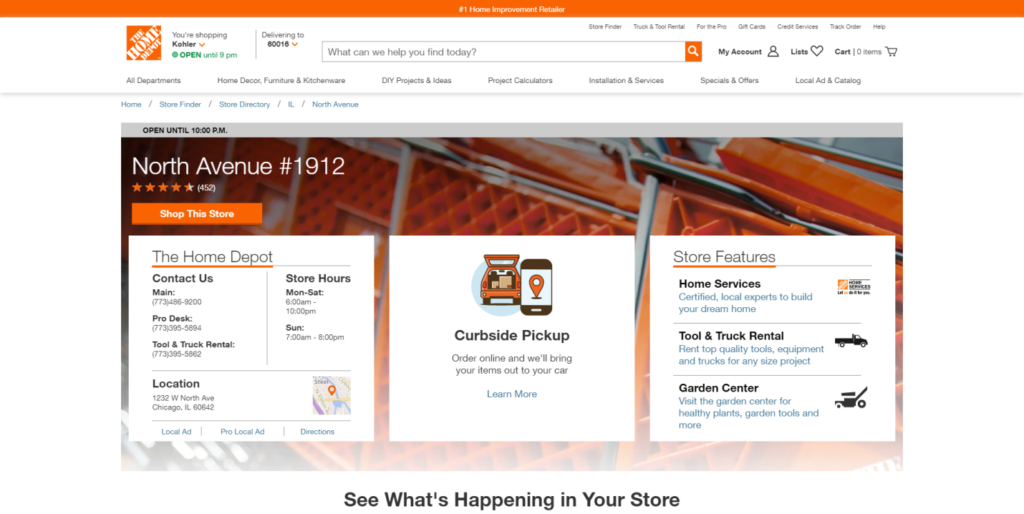
They provide contact details, local offers, sponsored and trending products, recycling information, comprehensive store details, and store reviews. This information is available for each local landing page.
Enterprise #5: Zillow
Zillow has been crushing SEO forever, am I right?
Zillow has so many different content permutations; their content targets the state level, city, region, county, and zip code; in some cases, Zillow even targets amenities.

This would technically be considered duplicate content; all of these different combinations display the same content repeatedly with minor copy edits specific to each locale. If you ask most SEOs, they’d say, “Hey, that doesn’t work” however, it works very well if you’re an enterprise.
Enterprise #6: TripAdvisor
TripAdvisor is legendary in the space for being so good at SEO.
They have a robust dataset where internally, they’re able to cross-tabulate any data point about their site from various perspectives (e.g., SEO, UX, CX, etc.) to see the impact their changes are having.
Here’s a look at their search results.
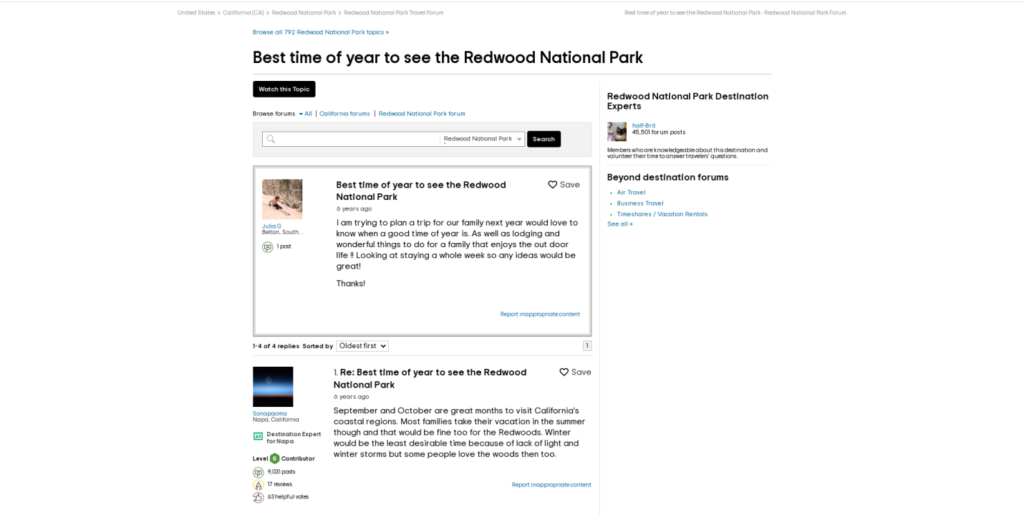
And their landing pages.

TripAdvisor leverages its users for content. Threads of user-generated content (UGC) often rank with contributors on the site writing in-depth responses. However, UGC isn’t the only strategy as there are designated pages for each location and sections like “attractions” and “nightlife.” Moreover, at the bottom of these pages, Q&A-style content gives TripAdvisor a chance to rank for quick answer results and queries using questions (often seen in voice search).
Enterprise #7: Healthline
Healthline has content for anything and everything around an ailment. They have a lot of your money, your life content, and they have a way to indicate that it’s evidence-based. This means they’re sending signals to users that this is content that’s compelling and relevant.
Take a look at the search results.

And their landing pages.
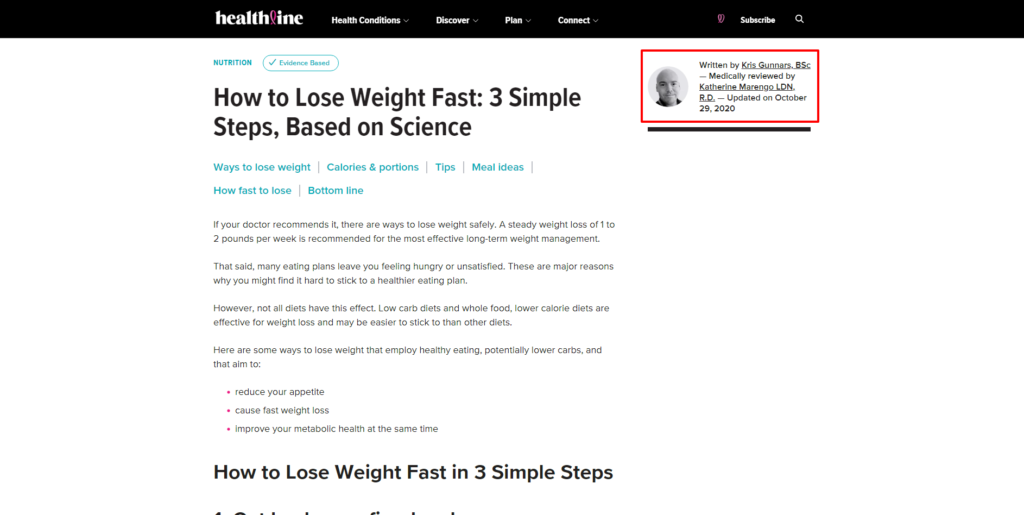
They’re leveraging doctors and healthcare professionals to create this content; that’s really important because so many sites rely on non-credentialed copywriters to write about these health-related topics. That’s part of the reason why Google came into the space. Healthline invests heavily in content; it’s an incredibly important thing to do just in general for SEO, but especially for enterprise SEO.
Enterprise #8: Indeed
Indeed came into the space with a focus on optimization, and they killed Monster and CareerBuilder and all those other websites, primarily because their SEO focus is so strong. And so, not only do they rank for the various combinations of posts (e.g., role and location), but they also rank for types of jobs and so on. They take all the different permutations of job-related content, and create a landing page for it.

Indeed’s collection of career opportunities categorized in various ways allows them to create dedicated pages to fields, locations, specific titles, etc. Not only do they rank for the long-tail keywords like “marketing jobs NYC,” but they also outperform on generic terms like “remote jobs” simply because of a great tagging structure.
Enterprise #9: eBay
eBay invented a lot of what we think of when we think of enterprise and SEO. One of the tactics that I talk about a lot is the programmatic internal link building that they do that’s based on rankings. They also are very strong at creating very robust category layer content. Take a look at how they inject their internal links in a relevant way.

Here are their landing pages.

See how they add these relevant links naturally?
eBay leverages its authority to boost pages via internal links. With countless pages to link from, every page directs SEO value to other valuable pages on their site.
Enterprise #10: Yelp
Yelp is obviously a dominant force around all things local. They really focus on ranking for “near me” modifiers. They develop these landing pages around these different locations and such, even if they’re not a part of the Yelp network. They went out and grabbed all the location data; they created landing pages for every restaurant, shoe store, etc. Next, they focus on permutations around locations (state, city, zip codes, etc.).

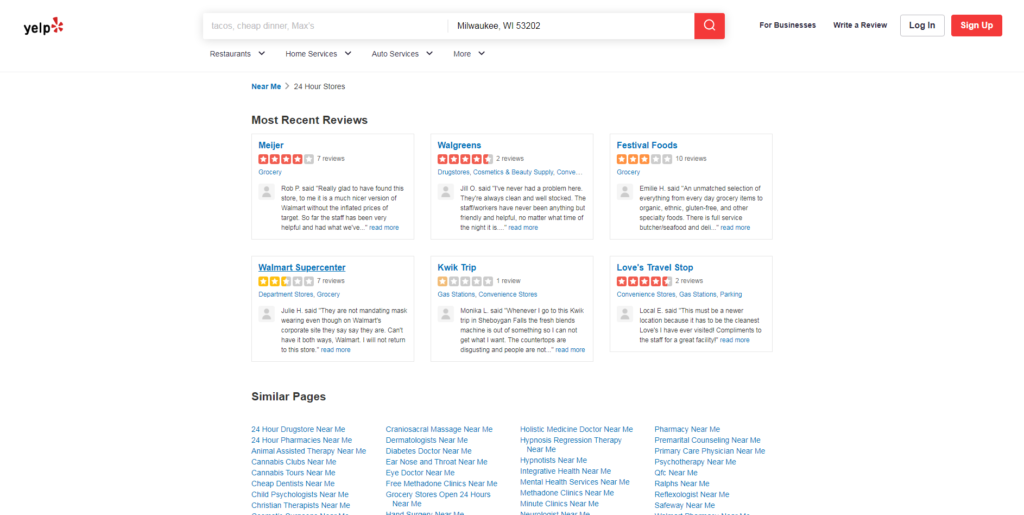
Remember, this is considered duplicate content because they’re pulling this stuff from a lot of different places, yet it works.
Common Enterprise SEO Problems and Solutions
What makes enterprise SEO so difficult for brands? Let’s take a look at some of the common problems and solutions in the space.
Frankenstein CMS
A big problem that you’re going to run into with enterprise SEO is the fact that there are many different CMS’s in play. You may be working with a CMS with SEO capabilities or built-in plugins — SiteFinity, WordPress, Kentico; these are all great until there’s more than one.
When a site is built using a variety of CMS, access, edits, and updates become difficult. Someone in your department doesn’t really have access to the CMS in another department, or it’s a legacy system that’s archaic or unknown. Now, you’re forced to answer difficult questions, i.e., where does one CMS end and another begin?
All of a sudden, something as simple as updating the navigation is complicated. You’re forced to go through four or five different parties just so you can have consistent navigation across the entirety of the website. Mike offered a peek into how to do SEO for any CMS that you can follow and begin to strategize around.
Legal compliance
When we’re dealing with enterprise SEO, there are different layers of compliance. It could be as simple as we’re not allowed to talk about these things in these ways. We’re not allowed to target certain keywords. We’re not allowed to even be in a SERP for some of these concepts. That has a direct impact on everything that you do and what you’re capable of doing. One of the bigger, more hidden problems that come from legal compliance is that the speed to deployment is difficult.
Let’s say there’s a new piece of news that you’d like to capitalize on with a piece of content; it’s going to be very difficult to get that out quickly.
Navigating multiple departments
You’ll need to put systems in place that (a.) show you which systems exist within the organization so you can work with others effectively and (b.) how to work effectively across various departments.
You may be working on something; someone else in a different department can actually be working on the same task or project as well. Or your whole idea could be squashed because someone else is working on it. Or maybe you’ve invested a significant amount of time on your project, but you need an unknown person in the Dubai office to weigh in on things.
These are all unexpected problems that complicate enterprise SEO.
This is why you’ll need information ahead of time. It’s crucial that you sit down with all your partners or stakeholders and figure out who the key people you need to engage with to get things done. You’ll need to know what you’re working with, dos and don’ts, and how to come together and combine your ideas.
Let’s take a closer look at some more specific problems.
Problem #1: Organizations purchase the wrong tools because SEO tool providers have strong sales teams.
Many SEO tools providers are aligned with how enterprise organizations work. They have really strong, structured sales teams — superstars from Salesforce or Google who are really good at selling, but their product is terrible.
Solution: Start by identifying the core features of the tools you’re considering, then tie them to the needs across the entire organization. Botify is a great example because it allows you to surface log files. There are a lot of teams across an organization that can benefit from direct access to log file intelligence. Bring that to decision-makers as a business case (i.e., Botify can do this, and these four groups need this functionality.
Next, talk with vendors.
If you’ve identified a tool that you’re ready to switch to, but the price is an issue, talk with the vendor. Let them know that you’d like to make the switch, but you’re currently spending X amount of dollars; see if there’s any wiggle room for an interim period. They may be willing to take a short-term loss for a long-term gain if it gets you to switch. That price may go back up to whatever it normally is in year two, but at that point, you will have enough of an opportunity to show the value of that tool.
Problem #2: You can’t build links due to legal compliance issues.
Solution: You’re in a tough spot due to industry requirements (e.g., financial or pharma). You can’t do outreach, and you can’t really deploy content. So what do you do? You buy websites; you look for websites that have a lot of link equity pointing to them, particularly relevant websites that are talking about very specific subjects that you’re also talking about. Then, once you’ve made the purchase, you redirect those sites to yours.
Here’s the thing.
You’ve got to do this in a very surgical way. You can’t just do a broad redirect (domain to domain). You’ve got to find the parity between pages so that Google believes that there’s real value being transferred. This strategy is particularly effective if you’re under a time crunch or working to recover from questionable tactics in the past.
Problem #3: Your organization doesn’t care about SEO.
Solution: Use education, business cases, and case studies to earn your organization’s buy-in. Use algorithm updates and KPIs to motivate them to take action. If, for example, an algorithm update impacts the KPIs of the people in the organization or department you need to get buy-in from, let them know that it will impact performance moving forward. Don’t be ashamed to use vanity metrics to your advantage.
What does this look like?
When C-level executives Google something, they’ll see that the organization ranks for a query that doesn’t move the needle a whole lot. Sure, it’s a keyword you prefer to rank for, but it’s not a make-or-break query for the organization. It’s still important to executives, and it’s still an effective way to get all the resources you need for your project or campaign.
Just a quick note on earning buy-in from executives.
Shantel Branch, our account executive at iPullRank, says, “it’s important to be prudent with your words and data points. Executives tend to be very busy and prefer to get to the bottom line as clearly and succinctly as possible.”
Problem #4: Content deployment takes too long. You can’t capitalize on news and trends.
Solution: Create a clearly defined content strategy. The more predictive and build out clear governance models and workflows throughout the content strategy.
What does this mean exactly?
It means taking the time to build out your cotton calendar, governance models, and workflows. Making sure you know who to talk to, how to get the approvals you need, etc., it’s easier to get things going faster when you’ve done the upfront planning you need.
Problem #5: Obsolete technology and Frankenstein content management systems prevent you from launching things.
Solution: Reverse proxy to WordPress; get a very usable CMS, then reverse proxy that into the site so that you have the control you need to get things done.
Problem #6: Brands have micro-sites for a variety of initiatives, and link equity is divided.
Solution: Consolidate all micro-sites into the core domain. Microsites are a problem; they’re great at attracting links, but they’re not adding value (via link equity) to the main site. What’s worse, these micro-sites aren’t generating enough of their own links to be truly competitive.
Consolidation is the best move here.
You can physically move these websites or use a reverse proxy. That can be challenging if you have multiple people managing the same site.
Problem #7: Line of business thinking for sites on one domain.
Let’s say you’re part of an insurance company; one group manages home insurance, another auto insurance. Both of these departments think of their part of the website as a completely different website. That’s a problem because, from Google’s perspective, it’s only one website.
Solution: This is where lunch and learn sessions can play a prominent role. Get key people from each of those conflicting or different lines of business together; sit them down, feed them, and educate them as to why it’s only one website from the perspective of Google.
Problem #8: They don’t want to make “SEO content” because that’s not what their audience wants.
Solution: For starters, that idea of SEO content is wrong. The idea that you make content for search engines and not for people is an antiquated perspective that comes from Google (in the past) not really understanding content the way they do now.
Google’s understanding of content today is dramatically more sophisticated.
Christopher Hart, director of revenue that iPullRank, says, “You just have to kind of help educate them that you’re not just writing for a print product anymore. You’re writing for a larger world thing and then bring that all together.”
What does this mean?
You’ve got to account for what your brands are trying to say, what people expect and need to know, and what search engines expect. It all comes down to good content, flat planning, and an effective roadmap. This is an important distinction to make; the content you create for your audience vs. buyers requires careful planning and management.
Problem #9: The organization’s silo. Different groups are not communicating, and that causes difficulty for the SEO program.
Solution: Reach out to people throughout the organization and network. The more people you engage with, the more you’ll be aware of what’s going on. You can expect everyone to always bring things to you. For example, paid search vs. organic search — those teams never talk to each other.
It’s really all about internal networking and building relationships.
The more you engage with folks, the more they’re going to let you know what they’re doing. Look for opportunities to add value; you’ll find that they are more likely to reach out for help in the future. This gives you the intel you need when unexpected changes take place.
Problem #10: Getting buy-in from the development team to implement changes. Getting buy-in from engineers, where they actually implement changes, is tough.
Solution: Learn to speak the product management language. Create user stories with very specific instructions for implementation. Product managers are actually very similar to SEOs; they have a wide variety of skills that they bring together to make a project happen from a technical perspective. They understand when things are broken, and they document what needs to be fixed via user stories.
This is what engineers need.
A detailed user story from the context of whether it’s a search engine or the actual user. It’s something that outlines what the user is trying to accomplish. This provides them with the context and content needed to get to work.
Problem #11: Because enterprise brands are typically huge siloed companies, they don’t really want to try anything new; they’re already doing great. They don’t want to rock the boat because they don’t want things to get worse.
Solution: Show the value of being innovative through case studies and business cases. Show what competitors are doing, explain why new techniques might be more beneficial than what is already out there, and how we can get where we need to be.
Here’s a great way to motivate them.
Provide case studies or business cases showing what your competitors are already doing. Find the two or three competitors in the space that are really dominating. The better you are at showing your competitor’s wins, the easier it is to earn buy-in with your initiatives.
Using business cases effectively
Building a business case is one of the best ways to earn buy-in.
Here’s an example.
I worked on a client — they had 12 million links pointing to 302 redirects. Sure, Google will say there’s no difference between 301 and 302 redirects. We knew a simple change would have a significant impact. Here’s how we changed their mind.
I ran the numbers. I told him 12 million links are pointing to 302 redirects; if you were to pay an SEO agency to build these links for you, here’s what it would cost. That number was obviously astronomical, but it showed them that they were wasting a valuable resource and losing a lot of traffic and revenue.
They actually decided to make the change. No surprise, there was a dramatic improvement in organic search visibility and traffic.
This is the power of a compelling business case, whether it’s showing that value in terms of the opportunity cost of paid search vs. organic or putting a dollar value on the things the organization is not doing. It’s effective, and it works.
How to find your internal champion
If you’d like to make things happen, you’ll need to find your internal champion.
This is the person who can actually push things through for you, giving you all the information that you need to make things happen.
Amplify this with competitive intelligence.
I can’t tell you how many times people have said, “Hey, we’re not doing this thing.”
As soon as I show what a competitor is doing, they feel they should do the same. You can use Searchmetrics or Semrush to gather those data points; be sure to show that data qualitatively on the site.
Then add workflows and governance models; map things out so that everyone knows what needs to be done. Identify all of the key players in your organization, then work with them to adjust those governance models and workflows to be more conducive to making things happen.
The importance of content strategy
When you’re thinking about content creation and content strategy, it’s got to be at that intersection of what the brand wants and what the audience wants. Often brands put something out there and demand that their SEOs optimize it. This isn’t a sustainable strategy; you always have to exist at that intersection. Find ways to operationalize the project. Build in your governance models; identify how people are working through creating this content to account for these things.
Use lunch and learns to educate and motivate.
People love to eat for free; they also love to learn about the things that can help them be better at their jobs, especially if it doesn’t require anything extra besides reaching out to you.
The more that you connect with your clients, whether internal or external, the more they will bring you the resources and buying you need to get things done. Find the best way to align the marketing mix, and avoid upsetting the apple cart. Find ways to deliver value but also have meaningful and helpful conversations with people. If you’re just talking about keywords and links and meta-tags, people on other teams are going to zone out.
Integrate search as much as possible into the marketing mix, working with key people on other teams.
Think like a product manager.
Embrace those agile methodologies, create user stories, and get comfortable having detailed conversations with your engineering teams. You’ll find your way more effective at pushing things through and getting things done.
Is your organization winning the enterprise SEO battle?
Brands that don’t invest in SEO stand to lose millions of dollars in lost traffic.
As we’ve seen, enterprise SEO isn’t about cutting-edge tactics; it’s about getting lots of people in your organization to apply basic strategies and tactics. The downside here is that it takes a little bit of time. The good news is that Google sees your brand as a solution to a much bigger problem.
Following a few of the basic details, we’ve covered today can significantly impact your enterprise SEO programs.
You can win with modern enterprise SEO.
Start with best practices, then move past them, testing things for yourself to see what will work best. Use this proven methodology to generate the wins your organization needs to pull ahead.
